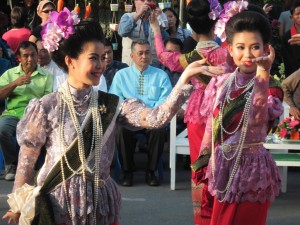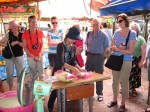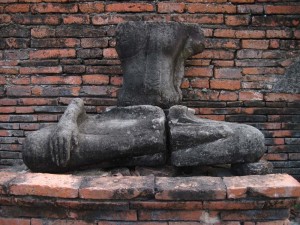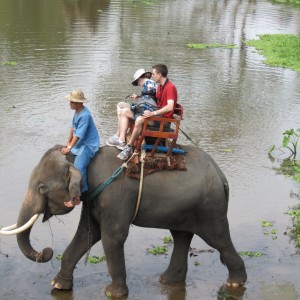Our second full day in Chiang Mai was spent with various activities. Thai monks are mendicants and live on food given to them early each morning. So the vanguard of the photo group headed out pre-dawn to CM gate market to capture the event. It was really a great “behind the curtain” connection experience. There were certainly no other tourists around. There were food stands set up for the specific purpose: people wandered in, bought a bag of food, and waited. The first monk appeared about 6:30. Several supplicants offered up their gifts. In return the monk blessed them and chanted for a couple minutes. I bought some “donation food” and proffered it to the next monk. He seemed not to miss a beat over my being a farang (foreigner), only adding a smile for me at the end. It gave me a warm feeling to participate - and there was absolutely no sense that I was not welcome to join in. Soon there was a fairly steady stream of the saffron-robed men. Later on two monks engaged us. The second spoke English well and had lived in Texas for a while. Both wanted to know where we were from, what we were doing in CM, and were we enjoying Thailand. Very cool.
It was really a great “behind the curtain” connection experience. There were certainly no other tourists around. There were food stands set up for the specific purpose: people wandered in, bought a bag of food, and waited. The first monk appeared about 6:30. Several supplicants offered up their gifts. In return the monk blessed them and chanted for a couple minutes. I bought some “donation food” and proffered it to the next monk. He seemed not to miss a beat over my being a farang (foreigner), only adding a smile for me at the end. It gave me a warm feeling to participate - and there was absolutely no sense that I was not welcome to join in. Soon there was a fairly steady stream of the saffron-robed men. Later on two monks engaged us. The second spoke English well and had lived in Texas for a while. Both wanted to know where we were from, what we were doing in CM, and were we enjoying Thailand. Very cool.
 Later that morning the majority of the group participated in a Thai cooking class. They were taken to the market to buy ingredients and spices, then returned to the school to learn how to prepare 3-4 dishes. I left them to their teachers and wandered the historic center capturing sound recordings and images for future Sightcasts. I recorded the van and Tuk Tuk drivers and their steady offers of “transport?”or “where you go?” and photographed the two main wats.
Later that morning the majority of the group participated in a Thai cooking class. They were taken to the market to buy ingredients and spices, then returned to the school to learn how to prepare 3-4 dishes. I left them to their teachers and wandered the historic center capturing sound recordings and images for future Sightcasts. I recorded the van and Tuk Tuk drivers and their steady offers of “transport?”or “where you go?” and photographed the two main wats.
In the afternoon we organized Songthaews (literally “two benches”, the pickup trucks with two benches and a covering, the predominant transport in CM and rural Thailand) to take us to the CM Flower Festival. There were some nice displays and some Thai dancing, but not the explosion of color I’d hoped for. Apparently, the big day was the next (our departure day) when they have a flower float parade. But it was still a fun look at a local celebration and fun to peruse the food stalls. I had the best sticky rice and mango of the trip.
two benches and a covering, the predominant transport in CM and rural Thailand) to take us to the CM Flower Festival. There were some nice displays and some Thai dancing, but not the explosion of color I’d hoped for. Apparently, the big day was the next (our departure day) when they have a flower float parade. But it was still a fun look at a local celebration and fun to peruse the food stalls. I had the best sticky rice and mango of the trip.
 That evening, for those interested, Ae and I took them to a Moo Kata restaurant. Equal parts warehouse production, giant buffet line, and "cook it yourself” extravaganza, this is a true Thai curtain experience. Each table is equipped with a cooking station. The attendant brings hot coals, and an inverted bunt cake shaped lid with a perforated dome in the middle is placed over the heat. Broth is poured in the “moat” and you are ready to cook. Ae gave us the rundown of the raw foods on the buffet: squid, shrimp, fish, eel, pork, liver, chicken, beef; vegetables and noodles; and on and on and on. You cook the proteins on the dome and the juices run down to flavor the broth. Vegetables and noodles are placed in the trough to make soup. Like the best travel food experiences, it is not just a great meal, but a true culinary experience. A dessert table rounds out the evening - all for a reasonable price.
That evening, for those interested, Ae and I took them to a Moo Kata restaurant. Equal parts warehouse production, giant buffet line, and "cook it yourself” extravaganza, this is a true Thai curtain experience. Each table is equipped with a cooking station. The attendant brings hot coals, and an inverted bunt cake shaped lid with a perforated dome in the middle is placed over the heat. Broth is poured in the “moat” and you are ready to cook. Ae gave us the rundown of the raw foods on the buffet: squid, shrimp, fish, eel, pork, liver, chicken, beef; vegetables and noodles; and on and on and on. You cook the proteins on the dome and the juices run down to flavor the broth. Vegetables and noodles are placed in the trough to make soup. Like the best travel food experiences, it is not just a great meal, but a true culinary experience. A dessert table rounds out the evening - all for a reasonable price.
























 After the market we headed into the historic center for Bangkok’s top sights. The splendor of Wat Phra Kheo, the centerpiece of the Grand Palace, is hard to describe or overstate: spectacular, stunning, dazzling, sensory overload, and overwhelming come to mind.
After the market we headed into the historic center for Bangkok’s top sights. The splendor of Wat Phra Kheo, the centerpiece of the Grand Palace, is hard to describe or overstate: spectacular, stunning, dazzling, sensory overload, and overwhelming come to mind.






































